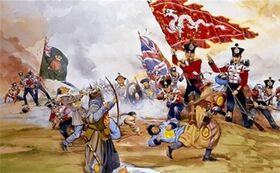Nihhonese Rebellion of 1868
| Choshin War | |||||||
|---|---|---|---|---|---|---|---|
 Lucian Troops during the Battle of Shinawara | |||||||
| |||||||
| Belligerents | |||||||
|
|
| ||||||
| Commanders and leaders | |||||||
|
|
| ||||||
The Nihhonese Rebellion of 1868 was a major uprising in Nihhon-koku between 1868–69 against the rule of the Chiyoda Company Post, which functioned as a sovereign power on behalf of the Lucian Crown. The event is known by many names, including the Choshin War, the Shogunate Mutiny, the Nihhonese Republican Revolt, and the Nihhonese Nationalist War.
The rebellion began on 7 August 1868. It then erupted into other mutinies and civilian rebellions chiefly in the southern plain and central Nihhon-koku, where most of Lucis Interest were located, though incidents of revolt also occurred farther north and east. The rebellion posed a considerable threat to Lucian power in that region, and was contained only with the rebels' defeat in Shinawara on 14 December 1868. On 25 December 1868, the Lucians granted amnesty to all rebels not involved in murder, though they did not declare the hostilities formally to have ended until 6 March 1869, when the Treaty of Chiyoda was signed.
The Nihhonese rebellion was fed by resentment that had emerged from Lucian rule, including invasive Lucian-style social reforms, harsh land taxes, summary treatment of some rich landowners and princes, and broader scepticism about the improvements brought about by Lucian rule. Many Nihhonese did rise against the Lucians, but many others fought for the Lucians, and the majority remained seemingly compliant to Lucian rule, including Emperor Meiyo since the government had been unstable long before the Lucians arrived in 1847. Violence, which sometimes betrayed exceptional cruelty, was inflicted on both sides; on Lucian officers and civilians (including women and children) by the rebels, and on the rebels and their supporters (sometimes including entire villages) by Lucian reprisals.
After the outbreak of the mutiny, the rebels very quickly reached Sendai, whose 47-year-old ruler, Enomoto Aikawa, was declared by the rebels as the President of the short-lived Ezu Republic. Soon, the rebels also captured large tracts of the North-Western Provinces. The Lucis Nihhon-koku Company's response came rapidly as well. With help from reinforcements, Hokkaido was retaken by mid-July 1868, and Sendai by the end of September. Even so, it then took the remainder of 1868 and the better part of 1869 for the rebellion to be suppressed in central and southern Nihhon-koku. Reinforcements also came from other Lucian Colonies in the Lucis Empire. Majority came from New Akiba, which had a majority of Nihhonese speaking troops (New Akiba was basically a penal land designated by the Emperor for convicts). The Empire of Nihhon-koku led by the Emperor firmly supported the Lucians because the company was doing a better job of running key Nihhonese cities than they could. Despite it, about 60% of Nihhonese clans did not accept the instance of Lucian rule.
In some regions, the rebellion took on the attributes of a patriotic revolt against Europan presence and power. However, the rebel leaders proclaimed no articles of faith that presaged a new political system. Even so, the rebellion proved to be an important watershed in Nihhonese and Lucian Empire history. It led to the dissolution of the Chiyoda Company Post, and forced the Lucians to reorganize the army, the financial system, and the administration in Nihhon-koku, through the passage of the Government of Nihhon-koku Act 1869. The Emperor, at the time, had finally submitted the rule over the whole Nihhonese archipelago to the Lucians. Nihhon-koku was thereafter administered directly by the Lucian government in the new Lucian Shihai. On 1 November 1869, King Regis Lucis Caelum CVI issued a proclamation to Nihhonese, which while lacking the authority of a constitutional provision, promised rights similar to those of other Lucian subjects. The following month on 25 December, the Nihhonese Emancipation Act of 1869 was officiated and gave all freedom and rights to the Nihhonese. In 1931, the Statute of Herrenhausen was signed, which gave Nihhon-koku (like the rest of the Lucian Colonies) the right to self-administer while the King remained head of state, becoming the modern Commonwealth of Nihhon-koku.
Today, the rebellion remains a crucial formation and the cornerstone that formed the modern closeness of the UK and Nihhon-koku.